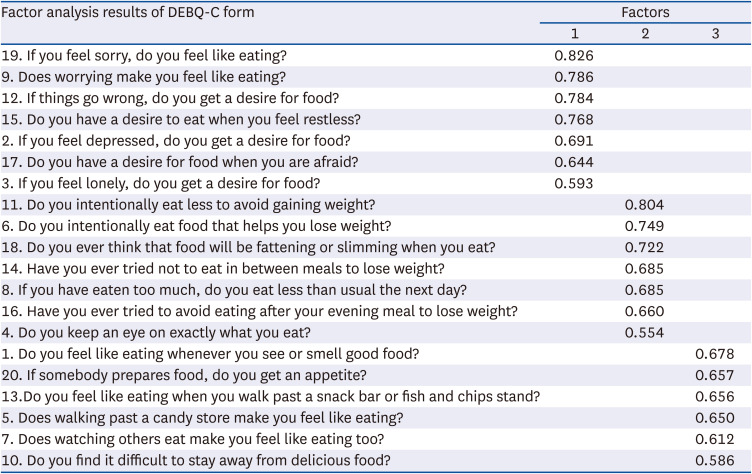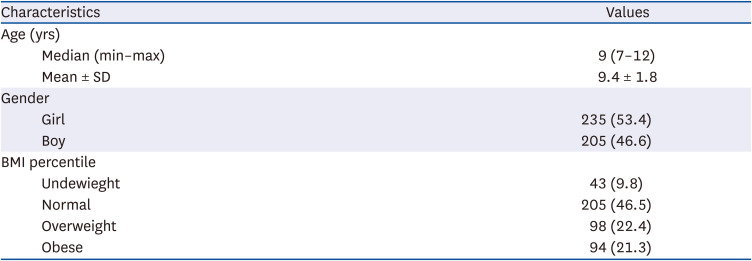1. Guo SS, Wu W, Chumlea WC, Roche AF. Predicting overweight and obesity in adulthood from body mass index values in childhood and adolescence. Am J Clin Nutr. 2002; 76:653–658. PMID:
12198014.

2. Baños RM, Cebolla A, Etchemendy E, Felipe S, Rasal P, Botella C. Validation of the Dutch Eating Behavior Questionnaire for Children (DEBQ-C) for use with Spanish children. Nutr Hosp. 2011; 26:890–898. PMID:
22470039.
3. American Psychiatric Association. Diagnostic and Statistical Manual of Mental Disorders: DSM-5. Washington, D.C.: American Psychiatric Association;2013.
4. Kaplan HI, Kaplan HS. The psychosomatic concept of obesity. J Nerv Ment Dis. 1957; 125:181–201. PMID:
13481715.

5. Bruch H. Psychological aspects of overeating and obesity. Psychosomatics. 1964; 5:269–274. PMID:
14235740.

6. Allirot X, Miragall M, Perdices I, Baños R, Urdaneta E, Cebolla A. Effects of a brief mindful eating induction on food choices and energy intake: external eating and mindfulness state as moderators. Mindfulness. 2018; 9:750–760.

7. Herman CP, Mack D. Restrained and unrestrained eating. J Pers. 1975; 43:647–660. PMID:
1206453.
8. Archer LA, Rosenbaum PL, Streiner DL. The children’s eating behavior inventory: reliability and validity results. J Pediatr Psychol. 1991; 16:629–642. PMID:
1744810.

9. Wardle J, Guthrie CA, Sanderson S, Rapoport L. Development of the children’s eating behaviour questionnaire. J Child Psychol Psychiatry. 2001; 42:963–970. PMID:
11693591.

10. Braet C, Claus L, Goossens L, Moens E, Van Vlierberghe L, Soetens B. Differences in eating style between overweight and normal-weight youngsters. J Health Psychol. 2008; 13:733–743. PMID:
18697886.

11. van Strien T, Oosterveld P. The children’s DEBQ for assessment of restrained, emotional, and external eating in 7- to 12-year-old children. Int J Eat Disord. 2008; 41:72–81. PMID:
17634965.

12. Gorsuch RL. Exploratory factor analysis: its role in item analysis. J Pers Assess. 1997; 68:532–560. PMID:
16372866.

13. Brislin RW. The Wording and Translation of Research Instruments. New York (NY): Sage Publications, Inc.;1986.
14. de Onis M, Garza C, Onyango AW, Borghi E. Comparison of the WHO child growth standards and the CDC 2000 growth charts. J Nutr. 2007; 137:144–148. PMID:
17182816.

15. Hair JF, Black WC, Babin BJ, Anderson RE, Tatham RL. Cluster Analysis. Multivariate Data Analysis. 7th ed. Upper Saddle River (NJ): Pearson University Press;2010.
16. Nunnally JC. Psychometric Theory 3E. New York (NY): Tata McGraw-hill Education;1994.
17. Ferketich S. Focus on psychometrics. Internal consistency estimates of reliability. Res Nurs Health. 1990; 13:437–440. PMID:
2270309.
18. Wang YF, Chuang HL, Chang CW, Zauszniewski JA. Translation and psychometric analysis of the Chinese version of the Dutch Eating Behavior Questionnaire for Children (DEBQ-C) in Taiwanese preadolescents. J Pediatr Nurs. 2018; 39:e30–e37. PMID:
29366527.

19. Snoek HM, van Strien T, Janssens JM, Engels RC. Emotional, external, restrained eating and overweight in Dutch adolescents. Scand J Psychol. 2007; 48:23–32. PMID:
17257366.

20. Brugman E, Meulmeester JF, Spee-van der Wekke A, Beuker RJ, Zaadstra BM, Radder JJ, Verloove-Vanhorick PS. Dieting, weight and health in adolescents in The Netherlands. Int J Obes Relat Metab Disord. 1997; 21:54–60. PMID:
9023602.

21. Duckworth AL, Kim B, Tsukayama E. Life stress impairs self-control in early adolescence. Front Psychol. 2013; 3:608. PMID:
23443890.

22. Jasinska AJ, Yasuda M, Burant CF, Gregor N, Khatri S, Sweet M, Falk EB. Impulsivity and inhibitory control deficits are associated with unhealthy eating in young adults. Appetite. 2012; 59:738–747. PMID:
22885454.

23. Muraven M, Baumeister RF. Self-regulation and depletion of limited resources: does self-control resemble a muscle? Psychol Bull. 2000; 126:247–259. PMID:
10748642.

24. Geliebter A, Aversa A. Emotional eating in overweight, normal weight, and underweight individuals. Eat Behav. 2003; 3:341–347. PMID:
15000995.

25. van Strien T, Herman CP, Verheijden MW. Eating style, overeating, and overweight in a representative Dutch sample. Does external eating play a role? Appetite. 2009; 52:380–387. PMID:
19100301.

26. Nguyen-Rodriguez ST, Chou CP, Unger JB, Spruijt-Metz D. BMI as a moderator of perceived stress and emotional eating in adolescents. Eat Behav. 2008; 9:238–246. PMID:
18329603.








 PDF
PDF Citation
Citation Print
Print






 XML Download
XML Download